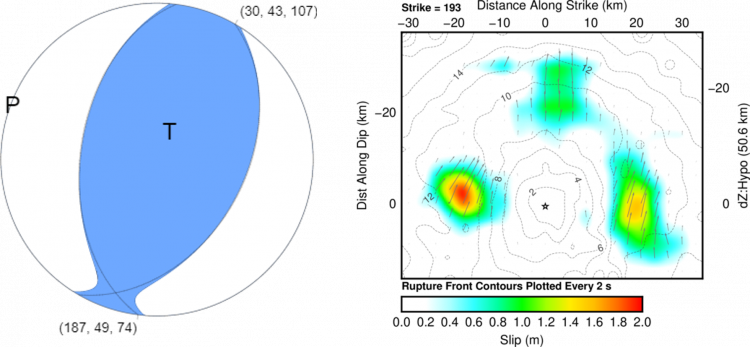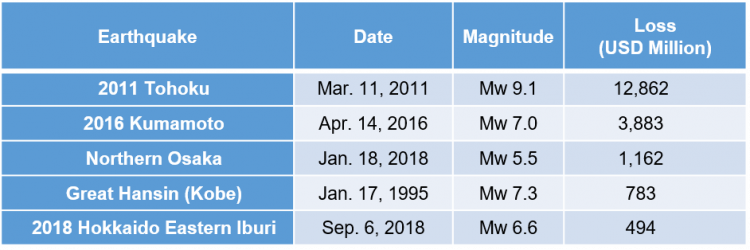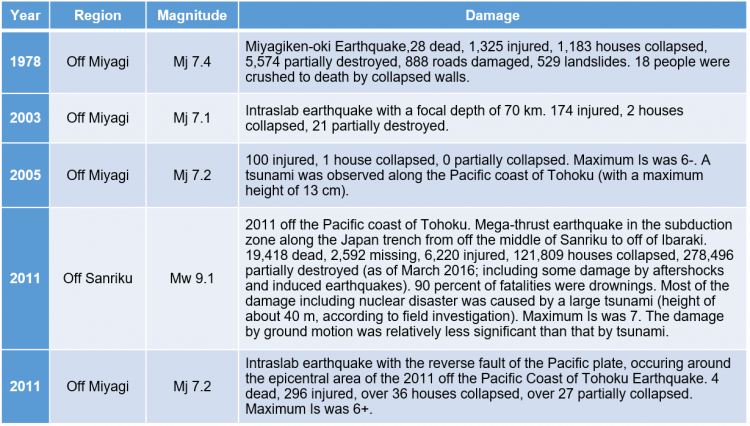
The Fukushima Mw 7.1 earthquake occurred at 23:07 local time (14:07 UTC), on Saturday February 13. The United States Geological Survey (USGS) reported the epicenter to be 96.6 km southeast of Sendai, Japan at a depth 49.9 km. The Japan Meteorological Agency (JMA) reported this event to be Mj 7.3, at a depth of 55 km. Multiple aftershocks occurred within less than an hour, and the largest one of Mw 5.3 occurred on February 15. The strongest reported intensity was Shindo 6+, using the JMA scale of zero to seven, in Miyagi and Fukushima Prefectures. The largest Modified Mercalli intensity (MMI) registered was VIII.
The 2011 Mw 9.1 Tohoku earthquake generated significant tsunami damage while the 2021 event did not trigger a tsunami warning or reported damages. Most of the historical tsunamis that cause fatalities are the result of offshore earthquakes at depths of less than 40 km. The 2011 Tohoku earthquake was at a depth of 32 km and the December 26, 2004 Indian Ocean earthquake and tsunami was at a depth of 30 km. This recent earthquake was at a depth of 55 km as reported by the JMA.

Observed JMA seismic intensity of the 2021 Mw 7.1 Fukushima Earthquake. Source: JMA.
Impacts
The Fire and Disaster Management Agency (FDMA) preliminary report on February 19 claimed that the earthquake caused injuries to at least 185 people across nine prefectures with 12 people suffering serious injuries. Reports indicate at least 100 people injured in Fukushima Prefecture and 63 in Miyagi Prefecture, with 30 in Sendai city.
Reports indicate at least 2,649 residential structures damaged in Miyagi and Fukushima Prefectures with the majority of damage occurring in the towns of Shinchi and Kagamiishi. At least 20 buildings were fully destroyed, while most other residential structures experienced partial or minor damage, according to an FDMA preliminary report. At least 950,000 households temporarily lost power nationwide. The Tokyo Electric Power Company (TEPCO) reported that no abnormalities or changes in radiation levels were detected at the Fukushima Daiichi and Daini nuclear power plants. Landslides caused damage to the coastal highway in Soma, Fukushima Prefecture.
Industrial impacts include the suspension of oil refining operations due to power outages in Chiba and Sendia. Mitsui Chemicals, Idemitsu Kosan and Eneos Holdings have all reported temporary suspension of some of their refineries. Mitsui Chemicals said its Ichihara plant in Chiba is likely to be offline for ten days.
The JR East railway and Tohoku Shinkansen bullet train have reported temporary suspension of services. JR East railway reported suspension of part of its high-speed train services due to damages to electrical lines while the Tohoku Shinkansen bullet train line will need ten days to resume its full service, according to NHK.
Murata Manufacturing temporarily suspended operations at its Fukushima and Miyagi facilities and Renesas Electronics halted operations at its Ibaraki factory to inspect the building's clean rooms. Toyota Motor Corporation announced the suspension of vehicle production at nine plants from one to four days beginning February 17. Nissan Motors, which has a manufacturing facility in Fukushima, reported their factories were not affected.
Physical Discussion
The Mw 7.1 Fukushima earthquake occurred as the result of thrust faulting near the subduction zone between the Pacific and North America plates. Source inversion results approximately describe the earthquake as slip over a reverse (thrust) fault area as shown below. The seismicity in this region is very high with 33 earthquakes of Mw 7 or larger having occurred within 250 km of this event in the past century.

Source inversion results of the Mw 7.1 Fukushima earthquake. Moment tensor solution (left) and finite fault slip solution (right). Source: USGS.
Historical Perspective
The five largest historical industry insurance losses reported by the General Insurance Association of Japan (GIAJ) are listed below (in USD million), using an exchange rate of 1 USD to 100 JPY. The 2011 Tohoku earthquake was an offshore event while the remaining earthquakes all have epicenters directly below Japan.

GIAJ Five Largest Industry Loss Events. Source - https://www.sonpo.or.jp/en/statistics.
Over the past 45 years, there have been five other earthquakes of Mw 7.0 or larger in this area as shown below.

Earthquakes of Mw 7.0 or higher in the same area over the past 45 years.
Source: National Astronomical Observatory of Japan, Chronological Scientific Tables, Maruzen, (2017) - https://www.j-risq.bosai.go.jp/report/en.[/caption] Sources: USGS, NHK, BBC, The Straits Times, Bloomberg, USNEWS, Fire and Disaster Management Agency (FDMA), National Research Institute for Earth Science and Disaster Resilience (NIED) and Japan Meteorological Agency (JMA).